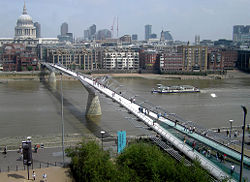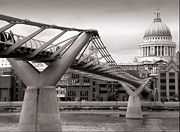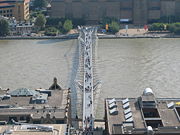Millennium Bridge (London)
| Millennium Bridge | |
|---|---|
 The bridge seen from a restaurant in the Tate Modern gallery. St. Paul's Cathedral is on the left |
|
| Official name | London Millennium Footbridge |
| Carries | Pedestrians |
| Crosses | River Thames |
| Locale | London, England |
| Maintained by | Bridge House Estates, City of London Corporation |
| Design | Suspension Bridge |
| Longest span | 144 metres (472 ft) |
| Total length | 370 metres (1,214 ft) |
| Width | 4 metres (13 ft) |
| Opening date | 10 June 2000 |
The London Millennium Footbridge is a pedestrian-only steel suspension bridge crossing the River Thames in London, England, linking Bankside with the City. It is located between Southwark Bridge (downstream) and Blackfriars Bridge (upstream). With construction beginning in 1998, it is owned and maintained by the Bridge House Estates a charitable trust overseen by the City of London Corporation.
Londoners nicknamed the bridge the Wobbly Bridge after crowds of pedestrians felt an unexpected swaying motion on the first two days after the bridge opened. The bridge was closed and modified, and further modifications eliminated the "wobble" entirely.
The southern end of the bridge is near Globe Theatre, the Bankside Gallery and Tate Modern, the north end next to the City of London School below St Paul's Cathedral. The bridge alignment is such that a clear view of St Paul's south facade is presented from across the river, framed by the bridge supports, thus providing a scenic view of the cathedral.
![]() The nearest London Underground station is Blackfriars.
The nearest London Underground station is Blackfriars.
Contents |
Design
The design of the bridge was the subject of a competition organised in 1996 by Southwark council. The winning entry was an innovative "blade of light" effort from Arup, Foster and Partners and Sir Anthony Caro. Due to height restrictions, and to improve the view, the bridge's suspension design had the supporting cables below the deck level, giving a very shallow profile. The bridge has two river piers and is made of three main sections of 81 metres (266 ft), 144 metres (472 ft) and 108 metres (354 ft) (North to South) with a total structure length of 325 metres (1,066 ft); the aluminium deck is 4 metres (13 ft) wide. The eight suspension cables are tensioned to pull with a force of 2,000 tons against the piers set into each bank — enough to support a working load of 5,000 people on the bridge at one time.

Construction

Construction began in late 1998 with the main works beginning on 28 April 1999 by Monberg Thorsen and Sir Robert McAlpine.[1] The bridge was completed at a cost of £18.2m (£2.2m over budget) and opened on 10 June 2000 (2 months late). Unexpected lateral vibration (resonant structural response) caused the bridge to be closed on 12 June for modifications.
Attempts were made to limit the number of people crossing the bridge: this led to long queues, but dampened neither public enthusiasm for what was something of a white-knuckle ride, nor the vibrations themselves. The closure of the bridge only three days after opening attracted public criticism, as another high-profile British millennium project suffered an embarrassing setback, akin to how many saw the Millennium Dome.
Further modifications to the bridge successfully eliminated the "wobble," which has not recurred since the bridge reopened in February 2002.
The bridge was temporarily closed on 18 January 2007, during the Kyrill storm due to strong winds and a risk of pedestrians being blown off the bridge.[2]
Resonance

The bridge's movements were caused by a 'positive feedback' phenomenon, known as Synchronous Lateral Excitation. The natural sway motion of people walking caused small sideways oscillations in the bridge, which in turn caused people on the bridge to sway in step, increasing the amplitude of the bridge oscillations and continually reinforcing the effect.[3]
The bridge opened on an exceptionally fine day, and it was included on the route of a major charity walk. On the day of opening the bridge was crossed by 90,000 people, with up to 2,000 on the bridge at any one time.
Resonant vibrational modes due to vertical loads (such as trains, traffic, pedestrians) and wind loads are well understood in bridge design. In these cases the forces which cause the vibration are transient, so do not need to be considered as participating directly with the structure; they just apply a force but do not interact with it.
In the case of the Millennium Bridge, because the lateral motion caused the pedestrians loading the bridge to directly participate with the bridge, the vibrational modes had not been anticipated by the designers (Arup).[4]
The lateral vibration problems of the Millennium Bridge are very unusual, but not entirely unique.[5] Any bridge with lateral frequency modes of less than 1.3 Hz, and sufficiently low mass could witness the same phenomenon with sufficient pedestrian loading. The greater the number of people, the greater the amplitude of the vibrations. Other bridges which have seen similar problems are:
- Birmingham NEC Link bridge, with a lateral frequency of 0.7 Hz
- Groves Suspension Bridge, Chester, in 1977 during the Jubilee River Regatta
- Auckland Harbour Road Bridge, with a lateral frequency of 0.67 Hz, during a 1975 demonstration [6]
After extensive analysis by the engineers [1], the problem was fixed by the retrofitting of 37 fluid-viscous dampers (energy dissipating) to control horizontal movement and 52 tuned mass dampers (inertial) to control vertical movement. This took from May 2001 to January 2002 and cost £5m. After a period of testing, the bridge was successfully re-opened on 22 February 2002. The bridge has not been subject to significant vibration since.
An artistic expression of the higher-frequency resonances within the cables of the bridge were explored by Bill Fontana's 'Harmonic Bridge' exhibition at the Tate Modern museum in the summer of 2006. This utilised acoustic transducers placed at strategic locations on the cabling of the Millennium Bridge and the signals from those transducers were amplified and dynamically distributed throughout the Turbine Hall of the Tate by a program Fontana entered into the sound diffusion engine of the Richmond Sound Design AudioBox [2].
In Popular Culture
- The Millenium Bridge will appear in the upcoming film, Harry Potter and the Half-Blood Prince, which involves the bridge collapsing into the Thames by several of Voldermort's Death Eaters..[3]
See also
- Angers Bridge
- Brooklyn Bridge -- Pedestrian access
- Galloping Gertie, the original Tacoma Narrows Bridge that collapsed in 1940
Gallery
References
- ↑ Where Thames Smooth Waters Glide
- ↑ BBC news: "High winds cause damage at Lord's," January 18, 2007.
- ↑ Strogatz, Steven et al. (2005). "Theoretical mechanics: Crowd synchrony on the Millennium Bridge," Nature, Vol. 438, pp, 43-44.
- ↑ Strogatz, Steven. (2003). Sync: The Emerging Science of Spontaneous Order, pp. 174-175, 312, 320.
- ↑ Julavitz, Robert. "Point of Collapse," Village Voice. August 26, 2003.
- ↑ Dallard, P. et al. "The London Millennium Footbridge," Structural Engineer. November 20, 2001. 79:22, pp.17-35.
- Reaney, Patricia. (Nov. 6, 2005). "Why the Millennium Bridge wobbled". New Sunday Times, p. F20.
- Strogatz, Steven. (2003). Sync: The Emerging Science of Spontaneous Order. New York: Hyperion books. 10-ISBN 0-7868-6844-9; 13-ISBN 978-0-7868-6844-5 (cloth) [2nd ed., Hyperion, 2004. 10-ISBN 0-7868-8721-4; 13-ISBN 978-0-7868-8721-7 (paper)]
External links
- Millennium Bridge in the Structurae database
- Arup's Millennium Bridge site
- A PDF paper from Arup, discussing the engineering and resonance of the bridge.
- A paper from Taylor Devices Inc on the dampers retrofitted to the bridge
- Information about the GERB TMDs retrofitted to the bridge
- Brooklyn Bridge: lateral S-shaped vibration = pedestrian oscillations or "sway"
- An explanation into a Cambridge University paper about the Millennium Bridge and phase locking.
|
||||||||
|
||||||||